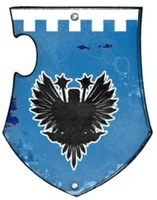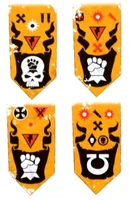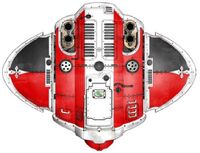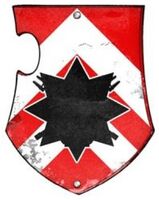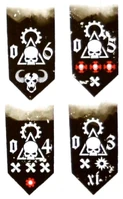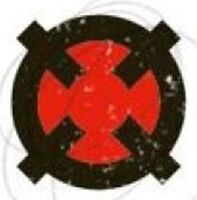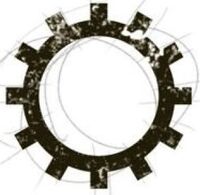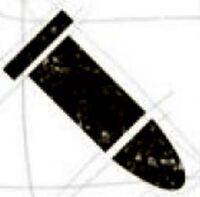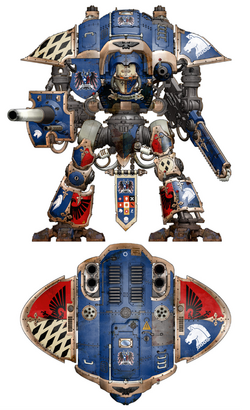
Example of the detailed chivalric livery utilised by Knights of House Terryn, a house of the Questor Imperialis.
Imperial Knight Heraldry is the practice of devising, granting, displaying, describing, and recording coats of arms and heraldic badges utilised by the Noble houses of Imperial Knights of the Questoris Familia.
Every Imperial Knight is a precious and valued war machine, revered by its Noble pilot and painstakingly maintained by the House Sacristans responsible for its upkeep. Each is painted in the glorious heraldry of its house, and decorated with imagery and iconography that tell of its homeworld, oaths and battle honours.
The Knight Houses use an elaborate system of heraldry signifying their allegiance, rank and the house to which they belong. Knights will use some variation of their house's heraldry as their livery, incorporating its themes and motifs, but no two liveries can be identical.
All Knights bear striking, colourful liveries and often adorn their war machines with heraldic pennants. It is customary for the Knights to compete not only in combat feats, but also in the appearance of their war mounts. Each symbol on an Imperial Knight has a powerful resonance for its wearer and a deep inner meaning.
In general, Knight houses belong to one of two major groups, the Questor Imperialis or the Questor Mechanicus. The Questor Imperialis includes those Knight houses which rule their Knight Worlds autonomously and swear direct allegiance to the Imperium of Man.
The Questor Mechanicus are the Knight houses which have sworn fealty first to the Adeptus Mechanicus and are now essentially extensions of the Mechanicus' own military forces, their Knight Worlds often just another territory of the feudal demesne of the closest Forge World.
History[]

The basic principles of Questor Imperialis Knight heraldry.
Housed in the labyrinthine expanse of the Emperor's Imperial Palace, within the Palace of Banners, the Officio Militaris College of Arms is an ancient institution whose Adepts-Pursuivant monitor, catalogue and approve the bewildering array of heraldic devices used by the various arms of the Imperium's military forces.
As the ultimate authority on all matters pertaining to sigils and marks of rank, and official arbitrators of the ownership of such marks, these Adepts wield much power within the ranks of the Imperial Court, and the Lord Adept-of-Arms maintains an advisory position within the Senatorum Imperialis itself.

The basic principles of Questor Mechanicus Knight heraldry.
Among the many duties of the Adepts of the College is that of cataloguing and recording the near-endless array of heraldry used by the recognised Imperial Knight houses. These Adepts, known as "Matriculators," are common sights on worlds controlled by Knight households, and are always accompanied by the stern Claviger Guard, who are sworn to see that none interfere with their duties.
Such is the importance placed upon the sanctity of their heraldic emblems and the privilege of use of coveted designs and insignia that many within a Knight house are willing to resort to violence to ensure their claim is honoured by their peers.
Questor Imperialis Heraldry[]
For Knights of the Questor Imperialis, a Knight's rank is discerned by the stripes across its carapace's armour. These stripes differ in colour for each house, but their colour is always sympathetic to the house's normal livery.
The honoured members of a house's Exalted Court each bear a specific design on their tilting plate, on top of which their house's icon is emblazoned. Whatever their house, a Knight's tabard will always feature certain details. The house's crest is borne in full, alongside the Knight's personal emblem and a number of his or her proudest battle honours.
Questor Mechanicus Heraldry[]
Like the knightly houses of the Questor Imperialis, the members of a Questor Mechanicus house's Exalted Court bear a specific design on their carapace to signify rank. Although houses dedicated to the service of the Machine God are less predisposed to tolerate personal heraldry than those who serve the Emperor directly, this does not, however, preclude individual differences. A Questor Mechanicus house's Barons Prime each sport a specific design commensurate with their rank on their tilting plate, displayed behind their house's icon.
House Heraldry[]
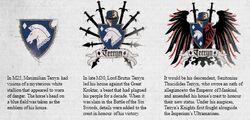
The evolution of the Questor Imperialis House Terryn's crest.
The Knight houses trace their origins to a period thousands of standard years before the birth of the Imperium of Man, so their banners present a visual language that appears to have evolved through time. Each began as a simple device, such as the white horse of House Terryn. Over the millennia, new alliances and significant events caused it to evolve into something grander, reflecting the complex relationship between the Knight house and the Imperium itself.
For instance, the Terryn white horse is symbolically linked to a vision that the house founder had way back in its distant past. Over the millennia, more heraldry, such as the helm above the crest and the swords behind were added (symbolic of an ancient battle), as was the house name.
Later, when High King Seuitonius Terryn swore allegiance to the Imperium of Man, the crest was marshalled, with the half-Aquila falling on the right side, and resplendent eagle wings as supporters. This half-and-half icon shows the observer the relationship between the knightly house and the Imperium, and the dichotomy of the Terryn Knights' loyalty to their house and the wider Imperium.
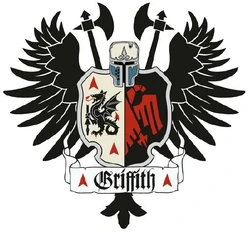
Heraldry of the Questor Imperialis House Griffith.
Other forms of Knight house heraldry, such as the house banner of House Griffith, possess subtle nods to events in their long, glorious history in the crest and secondary devices they employ. These are often very grand, with a mythological aspect to whatever symbols are chosen. House Griffith has fought wars against large reptilian creatures named "dragons" during their ancient history, and as such wear dragons as their crest. This desperate struggle served to harden the Griffith Nobles into skilled and fierce warriors.
Millennia later, House Griffith is sworn to the Imperium as a member of the Questor Imperialis, and has earned a reputation for producing some of the most formidable warriors ever to sit upon the Throne Mechanicum. The heraldry of House Griffith is halved with a dragon motif, connecting to their ancient history, and a red-winged Aquila, professing loyalty to Terra. What truth lies behind the dragon symbol is now the subject of legend as much as historical fact, but to the warriors of House Griffith, it is very important.
Essentially the same is true of the Questor Mechanicus houses. Their imagery tends more towards the industrial, with harder edges to their designs, where tools replace the swords and axes displayed by other houses. In the place of Imperial Aquilas, these Imperial Knights wear the half-cog of the Adeptus Mechanicus. The same dual-split remains here, with the Knights' loyalty divided between the house and the Cult Mechanicus.
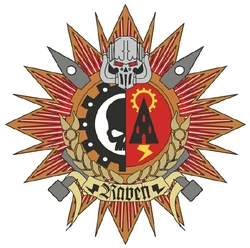
Heraldry of the Questor Mechanicus House Raven.
A perfect example is the crest of House Raven, foremost among the knightly houses aligned to the Adeptus Mechanicus. Their ancient alliance was brought about when a lord of House Raven witnessed the Magi of Forge World Metalica rouse to life Knight suits that had lain inoperable for centuries. The seat of House Raven's power is their indomitable fortress known as the Keep Inviolate, a foreboding structure on the Knight World of Kolossi. The full house crest of Raven bears homage to their heritage with the dual image of the Keep Inviolate and the Mechanicus' Opus Machina.
Finally, each Imperial Knight has the right to wear his or her own personal heraldry. Those of Questor Imperialis houses wear this on the front-right shoulder plate of their Knight. The form it takes is a matter of personal choice, although different houses have their own traditions. Questor Mechanicus houses do not typically bother with this at all. The Nobles from houses such as Krast and Raven are willingly subsumed into the service of the Machine God, and do not fear for their independence.
Pennants and Banners[]
Most Knights carry a variety of pennants and banners proudly proclaiming their heritage and battle honours. These flags are flown from carapaces and weapons but, most commonly, hang from the pinions that drive the war machine's powerful legs. Although the Knight houses remained independent and isolated from the rest of Mankind for millennia after the settlement of their homeworlds, their banners became more standardised when the Nobles bent their knee to the Emperor of Mankind or the Adeptus Mechanicus in His stead.
To this end, the banners of both Questor Imperialis and Questor Mechanicus Knights are broadly similar. The general format of a house banner has the house crest in its full form in the upper half of the pennant. All Knights from a single house will carry this identical sigil. The lower portion of the banner is devoted to kill, honour and campaign markings. These will differ from individual to individual, depending on where they have served and what honours they have gained. The exact layout and composition of these honours also varies from house to house. Some Knight houses prefer a relatively simple arrangement of these markings with coloured fields behind the icons, while others may favour a more complex array of icons and markings.
Heraldric Devices[]
Each suit of Knight armour piloted by Nobles of a Knight House of the Questor Imperialis will always display three things: the major plates display house symbols, most typically the house crest and lesser icons. The minor plates show Imperial heraldry. Finally, the Knight's front right shoulder guard is reserved for the personal heraldry of the Noble pilot -- this is a heraldic design which is unique to that specific warrior and none other.
Knight Houses dedicated to the service of the Machine God are less predisposed to tolerate personal heraldry; this does not, however, preclude individual differences. Also of note is the common practice of painting the Knight's faceplate in a black and white half-tone. Below are examples of some commonly deployed heraldic symbols.

A common Knight symbol used to illustrate opposition to the Forces of Chaos
- The Gauntlet - The symbol of an armoured gauntlet crushing a serpent symbolises House Krast's hatred of Chaos. The warriors of House Krast are violent opponents of the Forces of Chaos. Historically they were the first knightly house to join their forces to the Great Crusade, and they took great honour in their part of the Emperor's galactic conquest. But when the Horus Heresy reared its head, they suffered terribly. Chrysis, the home planet of House Krast, was utterly ravaged by the Traitors, and left as little more than a husk, reduced to a poisonous wasteland by the virus weapons unleashed upon it. Even 10,000 Terran years later, the Krast Nobles now live in void-shielded enclaves, and look out at their ruined world and feel a burning hate. Their icon is now the embodiment of their quest for vengeance, and they proudly tally the many Chaos worshippers they have defeated. Prosecuting this endless battle against the forces of the Dark Gods has become their driving motivation. Such is their venom that there is a secret place on their homeworld, known as the "Hammer of Traitors." Here they carve the names of Chaos worshippers they have destroyed -- and, rumour has it, bring prisoners to die terrible, gasping deaths in the poisonous air.

A kill marking specific to House Krast
- Knightly Honours - Glorious kills are celebrated by Imperial Knights with icons to be worn on their personal banner or suit of Knight armour. These take many forms, from targetting symbols or small skulls to rings around weapon barrels. House Krast's greatest hate is for the Legio Mortis, a Traitor Titan Legion who they hold accountable for the horrors unleashed on Chrysis. The broken death head symbol utilised by the Knights of House Krast is a modified badge of the Legio Mortis, with a crack which denotes a Titan kill of their most hated enemies.
Marks of Fealty[]
Every Imperial Knight wears an icon upon its carapace that proclaims the loyalty of its house to all that behold it:
- Imperial Eagle - The Imperial Eagle, or Aquila, is the icon worn by houses of the Questor Imperialis. It is worth noting that, while this icon proclaims a close military alliance, it does not imply any form of subjugation. Indeed, Knight houses see themselves as equals (if not betters) of the Imperium, alongside whom they fight for mutual benefit and as a sign of friendship.
- Machina Opus - The icon of the Adeptus Mechanicus, also known as the Cog Mechanicum, is worn by Imperial Knights in Questor Mechanicus houses which are aligned with the Priesthood of Mars. Houses that wear this mark not only fight alongside the Adeptus Mechanicus, and will answer a call for aid without hesitation, but can also rely on the industrial might of the Forge Worlds to supply and repair their war machines.
- Laurels Fidelis - Knights who take the mantle of Freeblades cast aside the heraldry of their former houses. Tradition dictates that these Nobles adopt the Laurels Fidelis, a laurel-wreathed skull which indicates their continued loyalty towards the Imperium of Man, despite leaving their houses behind. An Imperial Knight wearing this symbol will fight for Mankind, even until death.
Campaign Badges and Honour Badges[]
The kill, campaign and honour badges are a mix of local iconography (perhaps unique to a house) and sigils used by the armies of the Imperium. For example, if a Knight serves in an Imperial campaign, his banners would display the official badge for that action, and this sigil would also be worn by any Space Marines or Imperial Guardsmen involved.
The banners belonging to Freeblade Knights exemplify their individualism. They often echo the livery the pilots choose to apply over the top of their old house colours. Mottoes are not uncommon, or alternative versions of their house icons that these outcasts choose to identify themselves by. Such designs often reflect the fatalistic approach of the pilots -- with skulls and other memento mori represented in great number.
The pride of the Nobles who pilot the great Knight units is such that they will take any opportunity to proclaim their loyalties and achievements. To this end they often decorate the rear side of their banners. Though less visible, these spaces are used for catechisms, rolls of honour and lists of revered ancestors.
Freeblade Heraldry[]
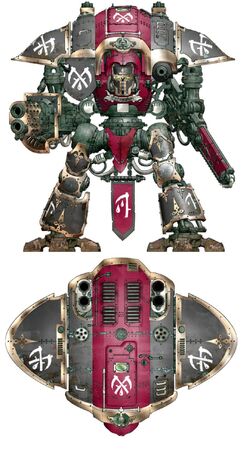
The Freeblade Knight known as the Crimson Reaper is as notorious for his murderous tendencies as he is for his deadly skill in battle
In stark contrast to the heraldry of the Questor Imperialis or Questor Mechanicus houses, the Freeblades use far simpler iconography. Freeblade Knights often spurn the heraldry of their old house, creating their own emblems as they strike out for a life of heroism and adventure on their own.
While house emblems reflect the collective history of a Knight World's Noble families, Freeblade icons are very personal to that individual. Mottos are often used as part of the design, and it is not uncommon for stylised skulls and skeletons to be used as a reminder that the Knight's quest will likely end with their death.
Despite the fact that there have been many cases of Freeblade Knights working in concert –- even as part of a household detachment –- over the Imperium's long history, the vast majority of them choose to fight alone. The reasons behind this solitary existence are many and varied, but it is certain that each Freeblade would have a long story to tell if ever they chose to reveal their past, though it is unlikely that the truth would be a pleasant one. It is their mysterious history that leads many Freeblades to forsake their origins and take on a whole new identity.
Many of these Knights choose to hide behind a cryptic name, though whether or not it is possible to discern a glint of a Freeblade's past from their choice of title is an enigma in itself. It is likely that after many long standard years of relentless warfare, some Knights may even have forgotten why they took their first step along the path of the Freeblade.
Unlike household Knights, Freeblades commonly choose a single colour as their suit's livery, adopting simple designs or patterns if any at all. Many choose to only show significant iconography on their tabard, though even these are symbolically selective in decoration. A Freeblade Knight's choice of livery and what passes for heraldry is unique, and no two Freeblades will ever look the same.
Questor Traitoris Heraldry[]
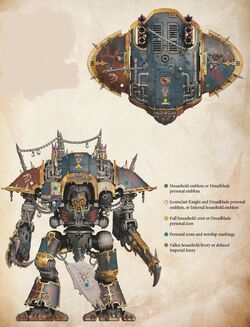
An example of the principles of heraldry used by most Chaos Knights.
Though the heraldry of Chaos Knights within a given Iconoclast or Infernal house follows the same pattern, there is a great deal of diversity between individual Knights, with each bearing markings that tell of its unique and bloody history.
The panoply of Dreadblades is even more diverse. These Chaos Knights eschew household markings in favour of personal emblems, and often bare twisted remnants of former Imperial iconography.
Knightly Titles[]
A consistent frustration experienced by the Administratum is the elaborate, often archaic forms of address used by the Noble houses. Not only does every Knight World have its own conventions, but even within the households of a single planet there may be multiple prefixes, suffixes and derivations that date back thousands of Terran years.
Complicating matters further, in many knightly cultures it is considered deeply offensive to address a Noble incorrectly. Duels to the death have been demanded for less, and more than one officious Administratum clerk has had to be hustled from a Noble's presence in a flustered panic before they dig themselves any deeper into trouble. Imperial authorities persist in their attempts to learn these archaic systems of name and title, however, as they are a vital part of communicating with the Knights in battle.
Beyond the relatively straightforward titles of the High Monarch and their Exalted Court, the vast majority of Knight Worlds tend towards "Sir" or "Lady" as a standard honour-prefix, although variations such as "Sire," "Sor," "Sar" and "Sirrah" are not uncommon.
Other worlds attach terms such as "most honoured" or "Become" after the Noble's name, or else a derivation of their homeworld such as "ap Kostonor" or "fon Medusar." Multiple terms denoting standing within a world's knightly houses are not uncommon: a Knight of a ruling household might be Lady Eleanora Uhl Tassos, while a lesser Noble of the same world might be Sir Geralt Lor Tassos. There are as many of these complex honorifics as there are stars in the Imperial skies, and all are of grave import to the Nobles who use them.
Sources[]
- Codex: Adeptus Mechanicus (8th Edition), pg. 27
- Codex: Chaos Knights (8th Edition), pg. 13
- Codex: Imperial Knights (8th Edition), pp. 18-20, 34-35, 42
- Codex: Imperial Knights (7th Edition) (Digital Edition), pp. 26-61, 64-75
- Codex: Imperial Knights (6th Edition) (Digital Edition), pp. 35-40
- The Imperial Knight Companion (6th Edition), pp. 16-19, 24-25, 27-28, 30, 33, 37, 39, 41, 43, 47, 49, 51, 53, 57, 59, 61, 63, 70-71, 73-74, 77-78, 83, 85, 87, 89, 93, 95, 97, 99, 109, 111-112, 117, 119-120, 125, 127-129, 133, 135-137, 139, 141, 143






